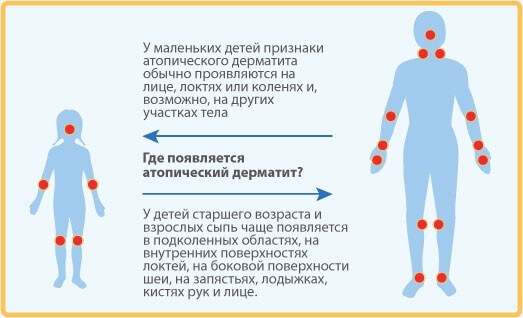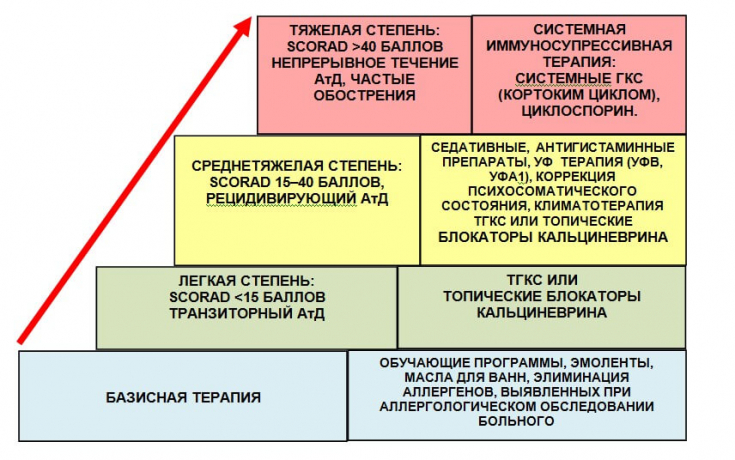Analyzing the composition of the treatment complex for children with atopic dermatitis, you are convinced that the methods of prescribing desensitizing therapy, correcting comorbidities, and local therapy are quite popular.
The problems of adequate nutrition, rational care, balance and staging of treatment remain quite real. It is them, first of all, that the doctor decides.
Find out in the article on estet-portal.com about all features of managing children with atopic dermatitis.
- Individual approach in the treatment of children with atopic dermatitis
- Steps in the treatment of atopic dermatitis in children
- The place of probiotics in the treatment of atopic dermatitis in children
- Hormonal therapy for atopic dermatitis in childrenher
Individual approach in the treatment of children with atopic dermatitis
No standards are possible in the treatment of children with atopic dermatitis because each case is different:
- reasons for sensitization;
- time of onset of skin syndrome;
- background states;
- age;
- power type;
- features of sanitary and hygienic living conditions, etc.
Follow us on Instagram!
This list of features is endless, but without its detailed analysis it is impossible to choose the right treatment tactics.

And therefore, the existing protocols for the management of children with atopic dermatitis determine only the nodal directions, goals of therapy, however, the need for targeted formation of the volume of treatment for each child in particular is highlighted at the present stage specialbut.
Stages of treatment of atopic dermatitis in children
Gradual treatment of atopic dermatitis involves correction of concomitant diseases (neurotic disorders, pathology of the digestive system, etc.), which should be stopped.
First of all, the attitude of clinicians to the problem of intestinal dysbiosis is ambiguous. From the terminology to the principles of treatment, the approaches are quite different.
It seems logical to interpret it as a secondary syndrome, which, in particular in atopic pathology, significantly reduces the immune defense at the intestinal level, which also affects the formation of a systemic immune response.
One of the most common routes for allergens to enter the body is through the alimentary canal. Under such circumstances, dysbiosis can not only influence the severity of the allergy, but also requires adequate management.

Most doctors try to treat or correct it, but it is advisable to help restoration of the obligate intestinal flora, the composition of which is too individual for each child. And therefore, attempts to eliminate intestinal dysbiosis are not clearly defined, since there cannot be a single norm for representatives of the flora, the composition of which depends on age, type of diet, living conditions, place of residence, and the like.
However, we know representatives of the dominant obligate flora (bifido- and lactobacilli), the promotion of whose growth can induce a balance in the ratio of other types of microorganisms. Therefore, the content of individual representatives of microorganisms in the composition of the probiotic is of great importance.
Why is xerosis of the skin common among young children?
Despite this, other requirements that are of particular importance in pediatrics cannot be neglected:
- convenient release form;
- adequacy of the composition to the age parameters of the contents of the intestinal flora;
- safetyth.
The place of probiotics in the treatment of atopic dermatitis in children
Given these points in children with atopic dermatitis (from 1 year of age), it is recommended prescription of probiotics (powders, chewable tablets). They contain bifidobacteria, lactobacilli GG and vitamins B1, B6, the endogenous deficiency of which in this group of patients is due to two reasons:
- underlying disease;
- existing secondary gut dysbiosis syndrome.
The content of lacto- and bifidobacteria provides establishment of the balance of the physiological intestinal microflora, and their protective and regulatory functions consist not only in stimulating the immune response, but also in inhibiting processes absorption of toxic products of distorted metabolism, inactivation of allergens, stoppedand processes of putrefaction in the intestines.
Hormonal therapy for atopic dermatitis in childrenPediatric practice requires
clear regulation of the use of corticosteroids:
- Maximum application area cannot exceed 20% of body surface;
- use of drugs with mild and moderate effects;
- contraindication for use in the area of the scrotum, vagina, physiological cavities, with caution in the face area;
- maximum duration of corticosteroids up to 14 days;
- selection of the most adequate application mode from the existing ones (stepped, tandem therapy, dashed);
- Dilution of topical corticosteroids for greater safety.
Immunological aspects of the development of atopic dermatitis
At the same time, even if there are indications for the appointment of topical corticosteroids, one should be aware of the possibleside effects, the severity of which increases in children of the first years, and therefore the most sparing method of application should be chosen.
The next step in the treatment of atopic dermatitis is to carry outspecific allergovaccination (covering children 3-5 years old) during a period of stable remission, which is carried out by an allergist.
More useful information on our YouTube channel:







Add a comment